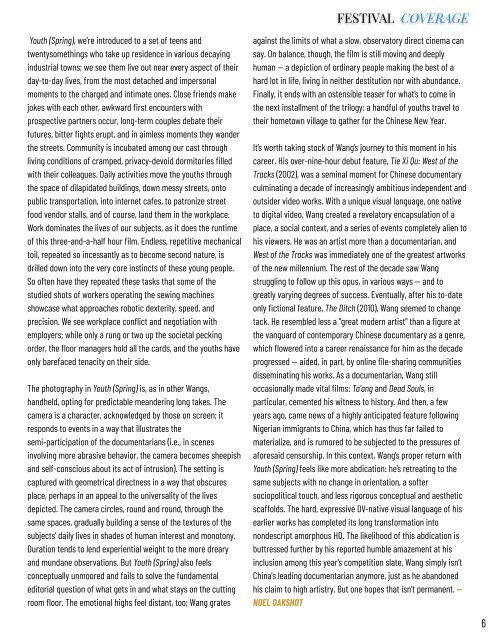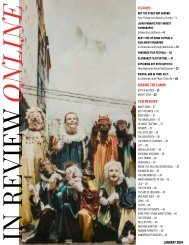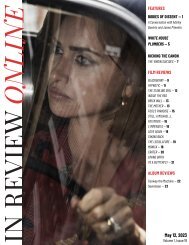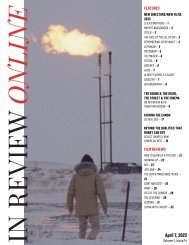You also want an ePaper? Increase the reach of your titles
YUMPU automatically turns print PDFs into web optimized ePapers that Google loves.
FESTIVAL COVERAGE<br />
Youth (Spring), we’re introduced to a set of teens and<br />
twentysomethings who take up residence in various decaying<br />
industrial towns; we see them live out near every aspect of their<br />
day-to-day lives, from the most detached and impersonal<br />
moments to the charged and intimate ones. Close friends make<br />
jokes with each other, awkward first encounters with<br />
prospective partners occur, long-term couples debate their<br />
futures, bitter fights erupt, and in aimless moments they wander<br />
the streets. Community is incubated among our cast through<br />
living conditions of cramped, privacy-devoid dormitories filled<br />
with their colleagues. Daily activities move the youths through<br />
the space of dilapidated buildings, down messy streets, onto<br />
public transportation, into internet cafes, to patronize street<br />
food vendor stalls, and of course, land them in the workplace.<br />
Work dominates the lives of our subjects, as it does the runtime<br />
of this three-and-a-half hour film. Endless, repetitive mechanical<br />
toil, repeated so incessantly as to become second nature, is<br />
drilled down into the very core instincts of these young people.<br />
So often have they repeated these tasks that some of the<br />
studied shots of workers operating the sewing machines<br />
showcase what approaches robotic dexterity, speed, and<br />
precision. We see workplace conflict and negotiation with<br />
employers; while only a rung or two up the societal pecking<br />
order, the floor managers hold all the cards, and the youths have<br />
only barefaced tenacity on their side.<br />
The photography in Youth (Spring) is, as in other Wangs,<br />
handheld, opting for predictable meandering long takes. The<br />
camera is a character, acknowledged by those on screen; it<br />
responds to events in a way that illustrates the<br />
semi-participation of the documentarians (i.e., in scenes<br />
involving more abrasive behavior, the camera becomes sheepish<br />
and self-conscious about its act of intrusion). The setting is<br />
captured with geometrical directness in a way that obscures<br />
place, perhaps in an appeal to the universality of the lives<br />
depicted. The camera circles, round and round, through the<br />
same spaces, gradually building a sense of the textures of the<br />
subjects’ daily lives in shades of human interest and monotony.<br />
Duration tends to lend experiential weight to the more dreary<br />
and mundane observations. But Youth (Spring) also feels<br />
conceptually unmoored and fails to solve the fundamental<br />
editorial question of what gets in and what stays on the cutting<br />
room floor. The emotional highs feel distant, too; Wang grates<br />
against the limits of what a slow, observatory direct cinema can<br />
say. On balance, though, the film is still moving and deeply<br />
human <strong>—</strong> a depiction of ordinary people making the best of a<br />
hard lot in life, living in neither destitution nor with abundance.<br />
Finally, it ends with an ostensible teaser for what’s to come in<br />
the next installment of the trilogy: a handful of youths travel to<br />
their hometown village to gather for the Chinese New Year.<br />
It’s worth taking stock of Wang’s journey to this moment in his<br />
career. His over-nine-hour debut feature, Tie Xi Qu: West of the<br />
Tracks (2002), was a seminal moment for Chinese documentary<br />
culminating a decade of increasingly ambitious independent and<br />
outsider video works. With a unique visual language, one native<br />
to digital video, Wang created a revelatory encapsulation of a<br />
place, a social context, and a series of events completely alien to<br />
his viewers. He was an artist more than a documentarian, and<br />
West of the Tracks was immediately one of the greatest artworks<br />
of the new millennium. The rest of the decade saw Wang<br />
struggling to follow up this opus, in various ways <strong>—</strong> and to<br />
greatly varying degrees of success. Eventually, after his to-date<br />
only fictional feature, The Ditch (2010), Wang seemed to change<br />
tack. He resembled less a "great modern artist" than a figure at<br />
the vanguard of contemporary Chinese documentary as a genre,<br />
which flowered into a career renaissance for him as the decade<br />
progressed <strong>—</strong> aided, in part, by online file-sharing communities<br />
disseminating his works. As a documentarian, Wang still<br />
occasionally made vital films: Ta'ang and Dead Souls, in<br />
particular, cemented his witness to history. And then, a few<br />
years ago, came news of a highly anticipated feature following<br />
Nigerian immigrants to China, which has thus far failed to<br />
materialize, and is rumored to be subjected to the pressures of<br />
aforesaid censorship. In this context, Wang’s proper return with<br />
Youth (Spring) feels like more abdication: he’s retreating to the<br />
same subjects with no change in orientation, a softer<br />
sociopolitical touch, and less rigorous conceptual and aesthetic<br />
scaffolds. The hard, expressive DV-native visual language of his<br />
earlier works has completed its long transformation into<br />
nondescript amorphous HD. The likelihood of this abdication is<br />
buttressed further by his reported humble amazement at his<br />
inclusion among this year’s competition slate. Wang simply isn’t<br />
China's leading documentarian anymore, just as he abandoned<br />
his claim to high artistry. But one hopes that isn’t permanent. <strong>—</strong><br />
NOEL OAKSHOT<br />
6
















